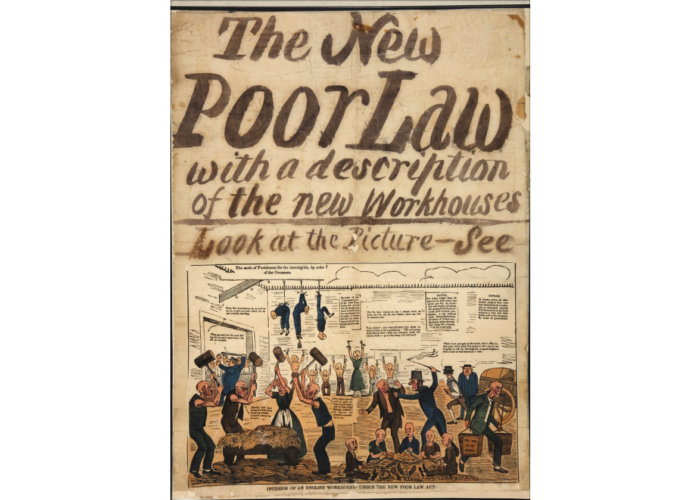Anti-Poor Law poster
Theme: The impact of industry, Economic and technological revolution
The New Poor Law of 1834 aimed to provide relief for the poorest members of society. It was introduced to reform a system that had been largely unchanged since the 1600s. It was intended to reduce the cost of supporting the poor and ensure the whole country was using the same system. But this new, draconian law, actually saw desperate men, women and children admitted to workhouses to live in appalling conditions. At this time, poverty was often blamed on the ‘bad character’ of the victim, assuming it their own fault if they were poor. As a result of this, many approved of the new law. Others, however, strongly opposed it, campaigning and even rioting in protest.
In the early 1800s, unemployment was high and poverty widespread – especially in the South of England. The end of the Napoleonic Wars, combined with the introduction of more and more machines in farming and other industries reduced the demand for soldiers, and changed the shape of the labour force. People migrated to towns and cities to work in mines, factories and mills, but wages were low and jobs often temporary or dangerous – leading to injury and further unemployment and exploitation.
Providing relief for the increasing number of people living in poverty was proving expensive for local parishes. Many also believed that the existing system had been too lenient and open to abuse by those considered ‘undeserving’ of help. The New Poor Law removed support for those ‘outside’ in the community and provided relief only through the workhouse system. Instead of providing refuge to society’s most vulnerable, workhouses were actually set up to be a ‘last resort’, to deter people from relying on the state for help.
In these dreaded institutions, people lived in terrible, dirty and cramped conditions. Families were separated on arrival, with men, women and children typically housed in separate buildings. They were given poor food and made to do hard, repetitive work, sometimes in uniform. Inmates usually slept in large, communal rooms with a central bucket for a toilet. There were strict rules, and harsh physical punishments for breaking them.
There was considerable opposition to the Poor Law. There were even riots in Northern towns like Oldham, Huddersfield and Bradford. Political campaigner Richard Oastler described the workhouses as cruel, un-Christian and ‘like prisons for the poor’.
The Local Government Act of 1929, eventually transferred powers for poor relief back to local authorities and many workhouses became small local hospitals. However, others continued as workhouses, under a new name, until the 1948 National Assistance Act finally saw them abolished.
Did you know..?
Charles Dickens wrote Oliver Twist to draw attention to the appalling treatment and conditions experienced by children born and raised in the workhouse system.
Use our Education activities to investigate this object and the theme of Protest further.
Highlights:
- Using objects, artworks and other sources to find out about the past
- Enquiry: How did workers protest during the Age of Revolution?
- How to make an interactive Revolutionary banner
- Twitter campaigns
And much more…
Sources & acknowledgements
This object description and its related educational resources were researched and written by our team of historians and education specialists. For further information see the item’s home museum, gallery or archive, listed above.
- Related resources
- Enquiry Questions
-
Did you know..?
Charles Dickens wrote Oliver Twist to draw attention to the appalling treatment and conditions experienced by children born and raised in the workhouse system.
-
Education overview
You can access a range of teachers resources related to this object and more on our education page.
Please also see our glossary of terms for more detailed explanations of the terms used.
-
Curatorial info
- Originating Museum: The National Archives
- Accession Number: HO 44/27 pt 2
- Production Date: c1834
- Creator: Home Office, Ministry of Home Security
- Original record
-
Use this image
You can download this image for personal and educational use but please take note of the license type and rights holder information.
- Rights Holder: The National Archives
- License Type: All Rights Reserved



